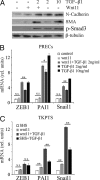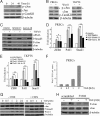Activation of Wnt11 by transforming growth factor-β drives mesenchymal gene expression through non-canonical Wnt protein signaling in renal epithelial cells
- PMID: 22556418
- PMCID: PMC3375550
- DOI: 10.1074/jbc.M112.357202
Activation of Wnt11 by transforming growth factor-β drives mesenchymal gene expression through non-canonical Wnt protein signaling in renal epithelial cells
Abstract
Transforming growth factor β1 (TGF-β) promotes renal interstitial fibrosis in vivo and the expression of mesenchymal genes in vitro; however, most of its direct targets in epithelial cells are still elusive. In a screen for genes directly activated by TGF-β, we found that components of the Wnt signaling pathway, especially Wnt11, were targets of activation by TGF-β and Smad3 in primary renal epithelial cells. In gain and loss of function experiments, Wnt11 mediated the actions of TGF-β through enhanced activation of mesenchymal marker genes, such as Zeb1, Snail1, Pai1, and αSMA, without affecting Smad3 phosphorylation. Inhibition of Wnt11 by receptor knockdown or treatment with Wnt inhibitors limited the effects of TGF-β on gene expression. We found no evidence that Wnt11 activated the canonical Wnt signaling pathway in renal epithelial cells; rather, the function of Wnt11 was mediated by the c-Jun N-terminal kinase (JNK) pathway. Consistent with the in vitro results, all the TGF-β, Wnt11, and JNK targets were activated in a unilateral ureteral obstruction (UUO) model of renal fibrosis in vivo. Our findings demonstrated cooperativity among the TGF-β, Wnt11, and JNK signaling pathways and suggest new targets for anti-fibrotic therapy in renal tissue.
Figures







Similar articles
-
β-Mangostin Alleviates Renal Tubulointerstitial Fibrosis via the TGF-β1/JNK Signaling Pathway.Cells. 2024 Oct 14;13(20):1701. doi: 10.3390/cells13201701. Cells. 2024. PMID: 39451219 Free PMC article.
-
Lack of microRNA-155 ameliorates renal fibrosis by targeting PDE3A/TGF-β1/Smad signaling in mice with obstructive nephropathy.Cell Biol Int. 2018 Nov;42(11):1523-1532. doi: 10.1002/cbin.11038. Epub 2018 Sep 14. Cell Biol Int. 2018. Retraction in: Cell Biol Int. 2024 Aug;48(8):1226. doi: 10.1002/cbin.12194. PMID: 30080287 Retracted.
-
Adipose mesenchymal stem cell-derived extracellular vesicles alleviate renal fibrosis by reducing epithelial-mesenchymal transition via the FOXS1/Wnt/β-catenin signaling pathway.Int Immunopharmacol. 2025 Jan 27;146:113880. doi: 10.1016/j.intimp.2024.113880. Epub 2024 Dec 21. Int Immunopharmacol. 2025. PMID: 39709913
-
TGF-beta1, WNT, and SHH signaling in tumor progression and in fibrotic diseases.Front Biosci (Schol Ed). 2017 Jan 1;9(1):31-45. doi: 10.2741/s470. Front Biosci (Schol Ed). 2017. PMID: 27814572 Review.
-
Wnt Signaling in Kidney Development and Disease.Prog Mol Biol Transl Sci. 2018 Jan;153:181-207. doi: 10.1016/bs.pmbts.2017.11.019. Epub 2017 Dec 30. Prog Mol Biol Transl Sci. 2018. PMID: 29389516 Free PMC article. Review.
Cited by
-
Noncanonical Wnt Signaling Promotes Myofibroblast Differentiation in Pulmonary Fibrosis.Am J Respir Cell Mol Biol. 2021 Nov;65(5):489-499. doi: 10.1165/rcmb.2020-0499OC. Am J Respir Cell Mol Biol. 2021. PMID: 34107237 Free PMC article.
-
Yi Qi Qing Re Gao-containing serum inhibits lipopolysaccharide-induced rat mesangial cell proliferation by suppressing the Wnt pathway and TGF-β1 expression.Exp Ther Med. 2016 Apr;11(4):1410-1416. doi: 10.3892/etm.2016.3027. Epub 2016 Jan 28. Exp Ther Med. 2016. PMID: 27073458 Free PMC article.
-
Applications and therapeutic mechanisms of action of mesenchymal stem cells in radiation-induced lung injury.Stem Cell Res Ther. 2021 Mar 25;12(1):212. doi: 10.1186/s13287-021-02279-9. Stem Cell Res Ther. 2021. PMID: 33766127 Free PMC article. Review.
-
Developmental signalling pathways in renal fibrosis: the roles of Notch, Wnt and Hedgehog.Nat Rev Nephrol. 2016 Jul;12(7):426-39. doi: 10.1038/nrneph.2016.54. Epub 2016 May 3. Nat Rev Nephrol. 2016. PMID: 27140856 Free PMC article. Review.
-
Kielin/chordin-like protein attenuates both acute and chronic renal injury.J Am Soc Nephrol. 2013 May;24(6):897-905. doi: 10.1681/ASN.2012070759. Epub 2013 Mar 28. J Am Soc Nephrol. 2013. PMID: 23539757 Free PMC article.
References
-
- Böttinger E. P., Bitzer M. (2002) TGF-β signaling in renal disease. J. Am. Soc. Nephrol. 13, 2600–2610 - PubMed
-
- Zeisberg E. M., Tarnavski O., Zeisberg M., Dorfman A. L., McMullen J. R., Gustafsson E., Chandraker A., Yuan X., Pu W. T., Roberts A. B., Neilson E. G., Sayegh M. H., Izumo S., Kalluri R. (2007) Endothelial-to-mesenchymal transition contributes to cardiac fibrosis. Nat. Med. 13, 952–961 - PubMed
-
- Kopp J. B., Factor V. M., Mozes M., Nagy P., Sanderson N., Böttinger E. P., Klotman P. E., Thorgeirsson S. S. (1996) Transgenic mice with increased plasma levels of TGF-β 1 develop progressive renal disease. Lab. Invest. 74, 991–1003 - PubMed
Publication types
MeSH terms
Substances
Grants and funding
LinkOut - more resources
Full Text Sources
Medical
Research Materials
Miscellaneous

